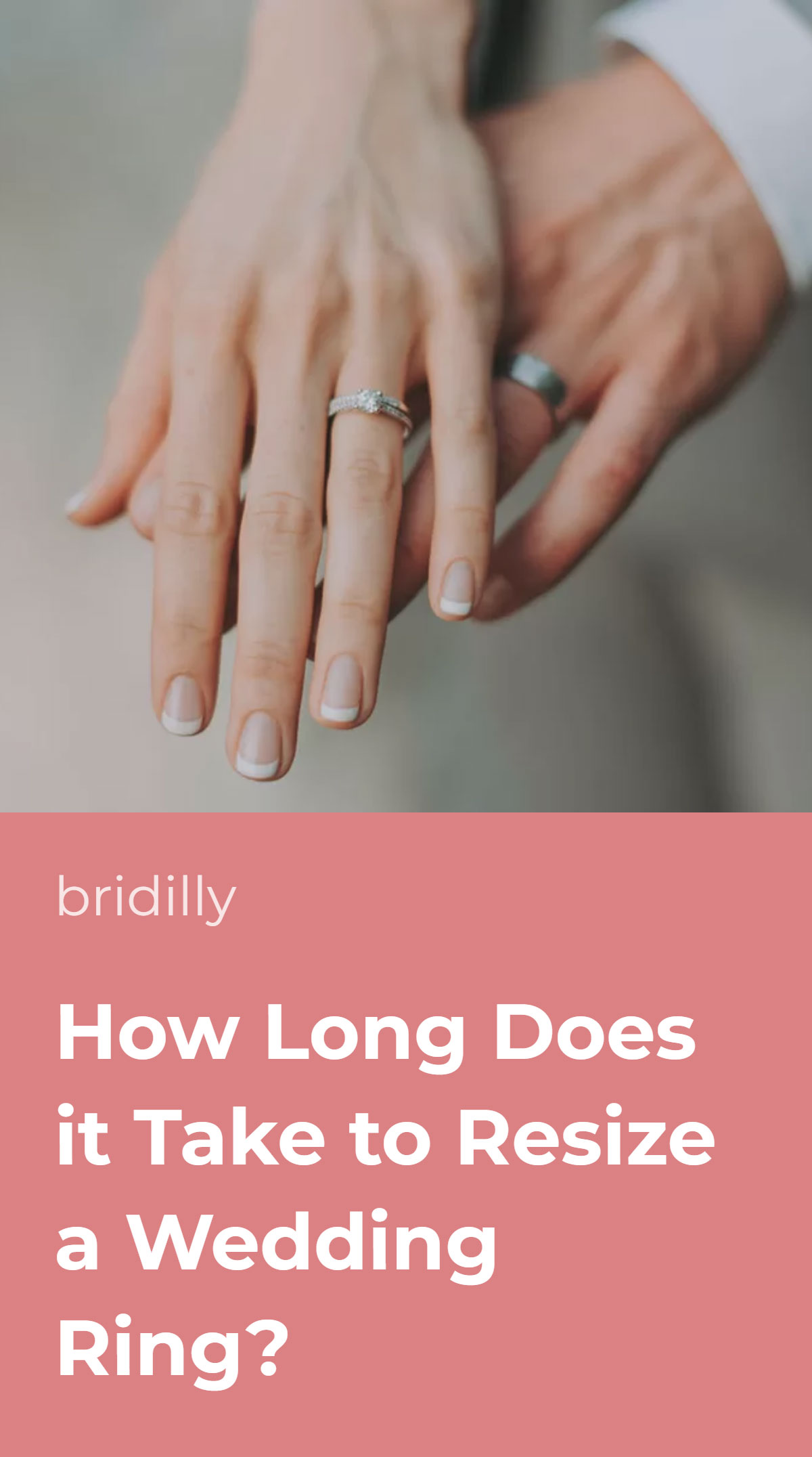The list of force majeure events that may interfere with your wedding plans is endless, and wedding ring resizing delay is one of them.
You may have incorrectly measured your finger, or the desired band was not available in your size. Either way, now you’re left wondering how to get your wedding band resized in time. Before you start panicking, inspect your ring based on several factors.
Wedding ring upsizing and downsizing take a different amount of time. The extent to which a ring must be resized also affects the process complexity, which, in turn, affects the time required.
The ring’s material plays a significant role in how long a wedding ring takes to resize.
Extremely hard or fragile metals require special equipment that may not be available at your local jeweler. In this case, you may have to send the ring elsewhere, prolonging the process.
Last but not least, the design intricacy. Plain bands can take under an hour to resize. So if you have a simple yellow gold band, rest assured your wedding will go as planned.
But if the ring features ornaments, engravings, or stones, the jeweler will need extra time to replicate the design. And some bands cannot be resized at all.
Table of Contents [show]
Upsize or Downsize?
Ring upsizing and downsizing are two completely different processes that vary in complexity and time required.
Wedding ring downsizing involves cutting out a piece of the band, shaping the bring back to a circle and soldering it.
A jeweler then polishes the ring to recover its initial visual state. After the process is complete, no evidence of resizing is left.
After downsizing a wedding band, you can ask the jeweler to keep the excess piece of metal. Hold back to it as you may need it after some years to upsize the ring.
Wedding ring upsizing, on the flip side, is a more complicated process. First, a jeweler needs to find the same metal as the ring is made of.
Then, they cut the ring, insert this piece, solder it, and polish it. Jewelers use this method mainly when rings must be resized over a half size.
Another way to make a wedding ring larger is to stretch the metal under heat and shape it. However, this process thins the band, so it may not be suitable for fragile pieces.
The time a jeweler spends resizing a ring depends on which manipulation they must perform. Upsizing also takes more time because the jeweler must find the same metal, which may not be available immediately.
Ring Material
Some rings materials are easier to work with than others, and some can’t be resized at all.
Typically, resizing is more effective with soft metals such as yellow gold, and silver. These metals can be stretched in any direction and shaped not to indicate any manipulations were done.
White gold is a bit harder to resize than yellow gold. After the manipulation, a jeweler must refinish the band and replate it with rhodium to bring back the color.
Platinum ring resizing is an even trickier process. A jeweler needs special tools as platinum has a higher temperature melting point. Stainless steel has the same issue, though it is rarely used for wedding bands.
Of course, the price of upsizing depends on the material, too. White gold is more expensive than yellow gold, and platinum is more costly than white gold. With downsizing, the material doesn’t play a role money-wise.
However, timewise, the material matters. Logically, the more complex is the process, the more time it takes.
Resizing a silver ring may take under an hour; resizing a platinum band can take a whole day. Of course, that’s only an estimate, as the time depends on numerous other factors.
Design Complexity
Deign intricacy plays a significant role in determining how long a ring will take to resize. The process with plain bands is quick and straightforward.
All the jeweler should care about is shaping the ring evenly and polishing it properly. But not all couples have simple wedding bands.
Plain bands with minimalistic design elements such as a straight-line engraving or simple ornament are relatively easy to resize, too. Most jewelers see no issue with replicating the missing pattern piece.
However, this will take additional time. Some patterns may also be complicated to join correctly after downsizing.
Another factor that affects the complexity of resizing a plain band is its thickness. Thick bands are at a lower risk of breaking during resizing.
However, with thin bands, the jeweler must be extra careful and may have to opt for a more time-consuming method.
Solitaire gemstone wedding rings can be easily resized, as the band itself doesn’t feature any elements.
The same applies to three-stone and more intricate gemstone designs placed on a plain band. This doesn’t affect the wedding ring resizing process and thus doesn’t take extra time.
The jeweler may need much more time or even refuse the service if a ring is covered halfway in gemstones. Also, even though a part of the band is bare, the jeweler may have trouble resizing a ring without damaging the stones.
Sometimes, gemstones must be removed from a ring before resizing it and inserted back afterward. This is especially relevant to soft stones such as pearl or cat-eye as they can be damaged under high temperatures.
In addition, the process requires great attention to detail and is very time-consuming.
If a ring features an overly complex design, it can be adjusted to your size without stretching or cutting it.
Instead, a jeweler attaches small metal balls or lining to the inner side of the ring, filling the space between the band and the finger.
The process takes less time than traditional resizing, but you may not feel comfortable in the ring after such a method.
Size Difference
The size difference doesn’t affect the time required to resize a ring drastically. However, it still matters.
Let’s take ring upsizing as an example. If you need to upsize a ring by under half a size, the jeweler can stretch it.
They don’t have to spend time searching for additional material to insert, cutting the ring, and soldering it.
If you need to upsize a ring drastically, the jeweler will have to perform a more complex procedure. The search for extra material alone may take weeks, depending on its availability.
And even if the metal is already available at the jeweler’s, they must cut the ring, sell it, and polish it thoroughly.
Furthermore, significant ring size changes often affect the design. The jeweler may have to replicate an engraving or move stones.
This is relevant to both upsizing and downsizing. Bringing back the ring’s visual appeal requires more time than the resizing itself.
Some jewelers may refuse to resize a ring if you need to adjust a gemstone ring by over three sizes. Others may offer you a complete shank replacement.
A jeweler must find a suitable material and craft a new band. They then cut out the part with a stone and ring shoulders, solder it to the new band, and polish it.
Simply put, this process is not much different from creating a new ring from scratch and takes an immense amount of time.
Amendments
After the ring is resized, you may not be satisfied with the result. This is because adjusting the size takes the same amount of time as the initial resizing.
Apart from the size adjustment, you may request to fine-tune the ornament or stone placement.
Some Rings are Impossible to Resize
The jeweler may refuse to resize your ring, and this doesn’t indicate a lack of professionalism.
Whether a band can be resized depends on the type of metal and the presence of bare metal. In addition, the jeweler needs enough room to work with.
Many professionals refuse to work with titanium rings due to the resizing complexity. However, it isn’t impossible.
The jeweler must have special tools and be experienced working with this material as its melting point stands at 3038 degrees Fahrenheit.
For the record, white gold melts at 1730 degrees Fahrenheit. If one jeweler says “no” to resizing your titanium ring, consult others in your area.
Unlike titanium, you can’t resize a tungsten wedding ring at all. This metal is too hard and can’t be shaped properly.
Its melting point is at 5200 degrees Fahrenheit, about three times higher than that of white gold. Tungsten is also extremely dense.
Black zirconium wedding bands can’t be resized, too. This is because the material’s melting point is only slightly lower than that of tungsten.
Rose gold rings may be impossible to resize for the opposite reason. This metal is more fragile than yellow or white gold and thus can crack during the manipulation. Such a difference is the result of copper alloy added into gold.
Not only the material matters. If your wedding band is covered in gemstones all way through, you may be refused to resize it in a traditional way. Full eternity bands have no bare metal to work with.
It may seem that the jeweler must simply cut out a couple of stones with a full eternity band. But in practice, doing so without damaging other stones is problematic.
The jeweler must remove all stones from a ring, cut out or insert a piece, and adjust the setting to conceal evidence of manipulation.
Then, all stones must be placed back. Only the most skillful jewelers can perform such delicate work, which takes an enormous amount of time.
















No Comments Add one
Leave a Comment